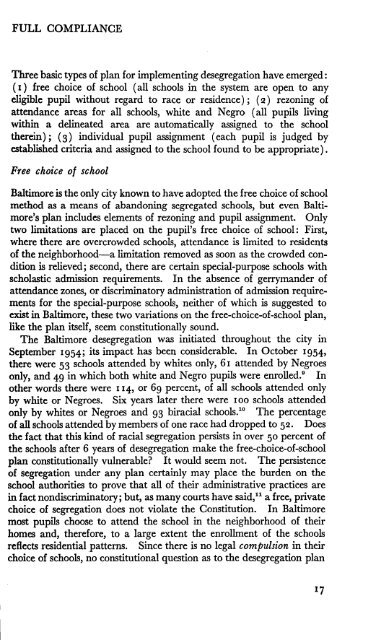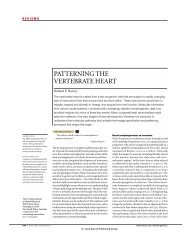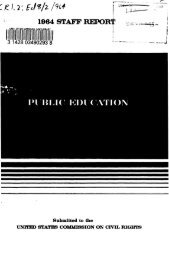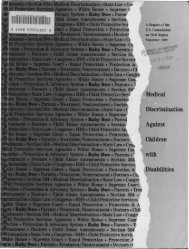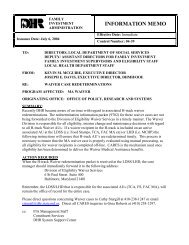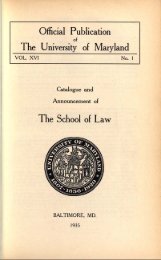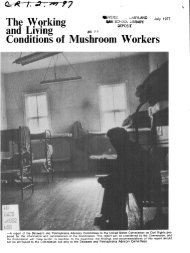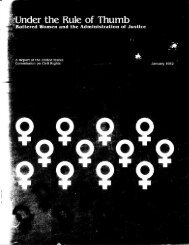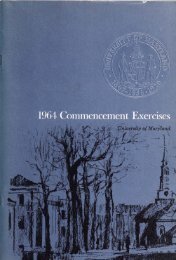1961 US Commission on Civil Rights Report Book 2 - University of ...
1961 US Commission on Civil Rights Report Book 2 - University of ...
1961 US Commission on Civil Rights Report Book 2 - University of ...
You also want an ePaper? Increase the reach of your titles
YUMPU automatically turns print PDFs into web optimized ePapers that Google loves.
FULL COMPLIANCE<br />
Three basic types <strong>of</strong> plan for implementing desegregati<strong>on</strong> have emerged:<br />
(i) free choice <strong>of</strong> school (all schools in the system are open to any<br />
eligible pupil without regard to race or residence); (2) rez<strong>on</strong>ing <strong>of</strong><br />
attendance areas for all schools, white and Negro (all pupils living<br />
within a delineated area are automatically assigned to the school<br />
therein); (3) individual pupil assignment (each pupil is judged by<br />
established criteria and assigned to the school found to be appropriate).<br />
Free choice <strong>of</strong> school<br />
Baltimore is the <strong>on</strong>ly city known to have adopted the free choice <strong>of</strong> school<br />
method as a means <strong>of</strong> aband<strong>on</strong>ing segregated schools, but even Baltimore's<br />
plan includes elements <strong>of</strong> rez<strong>on</strong>ing and pupil assignment. Only<br />
two limitati<strong>on</strong>s are placed <strong>on</strong> the pupil's free choice <strong>of</strong> school: First,<br />
where there are overcrowded schools, attendance is limited to residents<br />
<strong>of</strong> the neighborhood—a limitati<strong>on</strong> removed as so<strong>on</strong> as the crowded c<strong>on</strong>diti<strong>on</strong><br />
is relieved; sec<strong>on</strong>d, there are certain special-purpose schools with<br />
scholastic admissi<strong>on</strong> requirements. In the absence <strong>of</strong> gerrymander <strong>of</strong><br />
attendance z<strong>on</strong>es, or discriminatory administrati<strong>on</strong> <strong>of</strong> admissi<strong>on</strong> requirements<br />
for the special-purpose schools, neither <strong>of</strong> which is suggested to<br />
exist in Baltimore, these two variati<strong>on</strong>s <strong>on</strong> the free-choice-<strong>of</strong>-school plan,<br />
like the plan itself, seem c<strong>on</strong>stituti<strong>on</strong>ally sound.<br />
The Baltimore desegregati<strong>on</strong> was initiated throughout the city in<br />
September 1954; its impact has been c<strong>on</strong>siderable. In October 1954,<br />
there were 53 schools attended by whites <strong>on</strong>ly, 61 attended by Negroes<br />
<strong>on</strong>ly, and 49 in which both white and Negro pupils were enrolled. 9 In<br />
other words there were 114, or 69 percent, <strong>of</strong> all schools attended <strong>on</strong>ly<br />
by white or Negroes. Six years later there were 100 schools attended<br />
<strong>on</strong>ly by whites or Negroes and 93 biracial schools. 10 The percentage<br />
<strong>of</strong> all schools attended by members <strong>of</strong> <strong>on</strong>e race had dropped to 52. Does<br />
the fact that this kind <strong>of</strong> racial segregati<strong>on</strong> persists in over 50 percent <strong>of</strong><br />
the schools after 6 years <strong>of</strong> desegregati<strong>on</strong> make the free-choice-<strong>of</strong>-school<br />
plan c<strong>on</strong>stituti<strong>on</strong>ally vulnerable? It would seem not. The persistence<br />
<strong>of</strong> segregati<strong>on</strong> under any plan certainly may place the burden <strong>on</strong> the<br />
school authorities to prove that all <strong>of</strong> their administrative practices are<br />
in fact n<strong>on</strong>discriminatory; but, as many courts have said, 11 a free, private<br />
choice <strong>of</strong> segregati<strong>on</strong> does not violate the C<strong>on</strong>stituti<strong>on</strong>. In Baltimore<br />
most pupils choose to attend the school in the neighborhood <strong>of</strong> their<br />
homes and, therefore, to a large extent the enrollment <strong>of</strong> the schools<br />
reflects residential patterns. Since there is no legal compulsi<strong>on</strong> in their<br />
choice <strong>of</strong> schools, no c<strong>on</strong>stituti<strong>on</strong>al questi<strong>on</strong> as to the desegregati<strong>on</strong> plan<br />
I?


